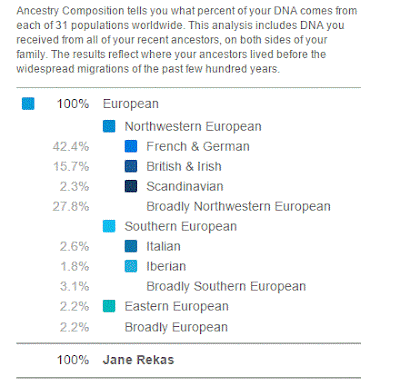My Maternal Haplogroup from 23andme
MATERNAL: CAMPBELL & HEYMAN
Origin and Migrations of Haplogroup T1a
Your maternal line stems from a branch of T1 called T1a. All the members of T1a can trace their maternal lines back to a woman who lived in the Middle East about 14,500 years ago. The world was just warming after the last great peak of the Ice Age, when the freezing climate had trapped much of the Earth's moisture in the ice sheets that covered not only the poles but also reached far down into all but the most southern reaches of Eurasia. The dry cold also created extreme deserts in the Arabian peninsula, restricting humans to a limited range of hospitable pockets. Then, as the ice gradually melted over thousands of years, the land outside of these refuges became habitable once again, and communities began to grow and re-expand. Some of the women in these migrations carried T1a to far reaches of the Middle East, North Africa, and all the way into western Europe.
Haplogroup T1a, though not exceedingly common, shows a remarkable geographic spread. Members of this group have been found in the range from the west in Scandinavia and the Baltic to the south in Morocco and to the east in Central Asia.
T1a1 7,000 Years Ago
Your maternal haplogroup, T1a1, traces back to a woman who lived approximately 7,000 years ago. That's nearly 280 generations ago! What happened between then and now? As researchers and citizen scientists discover more about your haplogroup, new details may be added to the story of your maternal line.
Although T1 is relatively rare in Europe today, it appears to have been much more common at some times in the past. Though it is present in only 2% of the modern English population, T1 was found at levels of 23% in DNA extracted from skeletons buried in Norwich, England during the 10th century AD.
But the complete absence of T1 even earlier, in DNA extracted from the skeletal remains of Anglo-Saxon Britons dating to the 5th and 6th centuries, suggests that the haplogroup did not arrive in England with the original agricultural expansion. It may have come with the Viking invaders who began menacing the coastal settlements of Britain and Ireland in AD 793."
Origin and Migrations of Haplogroup T1a
Your maternal line stems from a branch of T1 called T1a. All the members of T1a can trace their maternal lines back to a woman who lived in the Middle East about 14,500 years ago. The world was just warming after the last great peak of the Ice Age, when the freezing climate had trapped much of the Earth's moisture in the ice sheets that covered not only the poles but also reached far down into all but the most southern reaches of Eurasia. The dry cold also created extreme deserts in the Arabian peninsula, restricting humans to a limited range of hospitable pockets. Then, as the ice gradually melted over thousands of years, the land outside of these refuges became habitable once again, and communities began to grow and re-expand. Some of the women in these migrations carried T1a to far reaches of the Middle East, North Africa, and all the way into western Europe.
Haplogroup T1a, though not exceedingly common, shows a remarkable geographic spread. Members of this group have been found in the range from the west in Scandinavia and the Baltic to the south in Morocco and to the east in Central Asia.
T1a1 7,000 Years Ago
Your maternal haplogroup, T1a1, traces back to a woman who lived approximately 7,000 years ago. That's nearly 280 generations ago! What happened between then and now? As researchers and citizen scientists discover more about your haplogroup, new details may be added to the story of your maternal line.
Haplogroup T1 may have arrived in England with the Vikings.
Although T1 is relatively rare in Europe today, it appears to have been much more common at some times in the past. Though it is present in only 2% of the modern English population, T1 was found at levels of 23% in DNA extracted from skeletons buried in Norwich, England during the 10th century AD.
But the complete absence of T1 even earlier, in DNA extracted from the skeletal remains of Anglo-Saxon Britons dating to the 5th and 6th centuries, suggests that the haplogroup did not arrive in England with the original agricultural expansion. It may have come with the Viking invaders who began menacing the coastal settlements of Britain and Ireland in AD 793."






Comments
Post a Comment